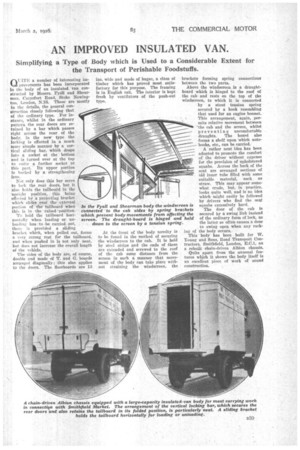AN IMPROVED INSULATED VAN.
Page 23

If you've noticed an error in this article please click here to report it so we can fix it.
Simplifying a Type of Body which is Used to a Considerable Extent for the Transport of Perishable Foodstuffs.
QTE a number of interesting ilnprovernents has been incorporated In the body of an insulated van constructed by Messrs. Fyall and Shearman, Carysfort Road, Stoke Newington, London, N.16. These are mostly in the details, the general construction closely following that of the ordinary type. 1-4‘or instance, whilst in the ordinary pattern the rear doors are retained by a bar which passes right across the rear of the body, in the new type the locking is effected in a much more simple manner by a vertical sliding bar, which drops into a socket at the bottom and is turned over at the top to enter a further socket at this part. Its upper portion is backed by' a• strengthening iron.
Nat only does this bar serve to look the rear doors, but it also bolds the tailboard in the 'upright position, this. :being 'effected by 7a projecting bracket which slids ov,ei the external portion of -the' tailboard when this is in the raised 'position. To hold the tailboard horizontally when loading • or unloading has to be. carried out, there is provided a sliding bracket which, when pulled out, forms a very strong rest for the tailboard, and when pushed in is not Only neat, but does not increase the overall length of the vehicle.
The sides of the body are, of course, double and made of T. and G. boards arranged diagonally; this also applies to the doors. The floorboards are 13
•
In ins, wide and made of bagac, a class of timber which has proved most satisfactory for this purpose. The framing is in English oak. The interior is kept fresh by ventilators of the push-out type.
At the front of the body novelty is to be found in the method of securing the windscreen to the cab. It is held by steel strips and the ends of these are extended and screwed to the roof of the cab some distance from the screen in such a manner that movement of the body can take place without straining the windscreen, the brackets forming spring connections between the two parts.
Above the windscreen is a draughtboard which is hinged to the roof of the cab and rests an the top of the windscreen, to which it is connected by a stout tension spring secured by a hook resembling that used for an engine bonnet. This arrangement, again, permits relative movement between 'the cab and the screen, whilst pre venting uncomfortable draughts. The board also forms a shelf upon which notebooks, etc., can be carried.
A rather neat idea has been adopted to promote the comfort of the driver without expense for the provision of upholstered squabs. Across the back of the seat are arranged sections of old inner tube filled with some suitable material, such as straw. This may appear somewhat crude, but, in practice, looks quite well, and is an idea which might easily be followed by drivers who find the sera squabs excessively hard.
The door of the cab is secured by a swing link instead of the ordinary form of lock, as the latter so often causes a door to swing open when any racking of the body occurs.
This body has been built for W. Young and Sons, Road Transport Contractors, Smithfield, London, E.C.1, on a rebuilt chain-driven Albion chassis.
Quite apart from the unusual features which it shows the body itself is an excellent piece of work of sound construction.




























